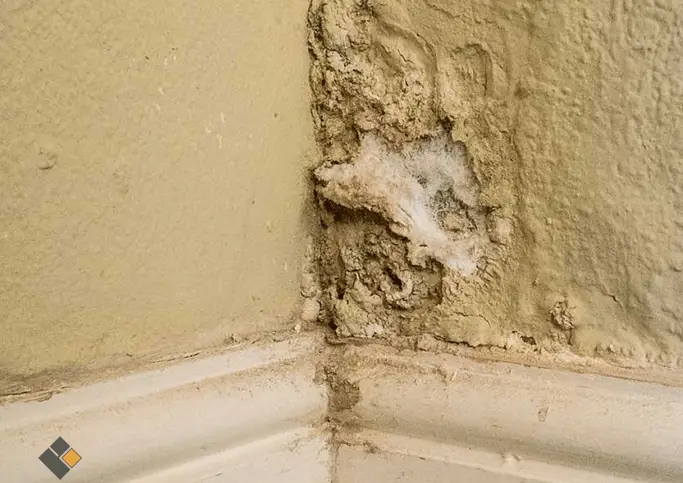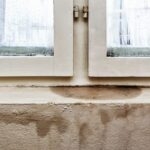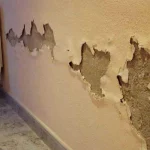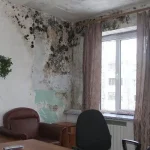How to effectively remove salt from walls
It is known that salt and moisture are among the most common damages to building structures, especially attacking facades and interior walls.
Among some of the forms in which moisture appears, salt is one such form and it must be taken into account that it is a type of stain that can indicate that a house or building has a deeper moisture problem and that it is necessary to treat it properly.

Therefore, to learn how to remove salts from the wall and what remedies are most suitable, today we will devote ourselves to understanding the reasons for the appearance of salt and the most suitable Montó products.
What do you do if you ever find salts on the walls?
Salts on the walls It is the kind of capillary moisture that appears in the form of white spots, as a result of the deposition of crystallized salts that appear on the surface.
The reason it usually appears on the facades and walls is that the building suffers from moisture problems from the ground, and that moisture pulls salts and other materials from the ground and walls that end up crystallizing and depositing on the surface of our facades and walls.
Therefore, the appearance of salt and moisture on the wall is not only an aesthetic problem, but also moisture that can cause more serious problems, since it is able to lift the paint and leave the wall completely unprotected from rain.
The sun facilitates the occurrence of cracks and leaks.
On the other hand, moisture generated by capillaries tends to diffuse easily.
Therefore, if there is a wall with salt stains, it is very likely that within a short period of time moisture will rise across the surface and may cause damages related to the installations it houses, such as pipe damage or electrical damage.
The appearance of salt spots on the facade or wall is directly related to the type and quality of the ground on which the structure is located.
It also has a great relationship with the composition, the materials used in the construction of the foundations, their resistance and their ability to insulate.
problems that can lie behind the appearance of salt and moisture
Given all the problems that can lie behind the appearance of salt and moisture from the floor, the first step in treating the walls is to carry out a diagnostic that reports:
- Surface properties with salt to be treated.
- The type and origin of moisture, not only to eliminate the surface problem, but also to take action to combat the root problem.
After such a preliminary analysis, the selection of products for removing salt on the walls will not only be easier, but also more effective.
As we’ve discussed on other occasions, diagnosing the origin of moisture is key to preventing home deterioration and ensuring that treatment that improves aesthetics, as well as insulation and sanitary conditions, is applied.
Products for the treatment of salt on the walls
Once we are clear about the composition and condition of the structure to be treated, it’s time to choose products that allow us to effectively remove salt from the walls.
Offers a wide range of products focused on the prevention, treatment and recovery of problems caused by moisture. To remove salt from the walls, our experts recommend the following:
Tixoway Antihumedad Water
It is a very effective paint to apply to interior walls with high humidity that need regular treatment.
It is a paint with high adhesion and high ventilation. This makes Tixoway Anti-Humidity Acqua allow water in wet areas to evaporate easily, without causing peeling or lifting of finished layers.
It is the most recommended type of paint for treating floor walls, basements or basements where condensation and lack of ventilation exacerbate moisture problems from the ground.
Plasmont Antihumedad
It is the main product for the protection and insulation of walls of various compositions, which usually suffer from moisture due to capillaries from the ground and foundations.
It is very effective both on brick, stone, concrete or mortar walls, whether interior or exterior.
Plasmont Anti-Humidity is also ideal for restoring walls damaged by soluble or soluble salts.
Another point in favor of this type of mortar is that it is valid as stucco or plaster.
In other words, it is also effective as an exterior or interior coating, which allows its application to also fulfill the function of a product that achieves a continuous and uniform finish.
If you are in doubt about how to complete the treatment to get rid of salt and moisture, the Montó Pinturas team can advise you so that the selection of products is correct and most effective for each of the surfaces to be treated.
Do you want to know in depth specific products for salt processing?
Enter our site and discover all our solutions to eliminate moisture.
Salt on the walls is one of the ways that moisture can show up in your home.
A type of stain may indicate that your home has a more serious moisture problem than it appears and will need treatment in order to find a permanent solution.
In this article we will talk to you about the reasons for the presence of salt on the walls, how it is produced and what solutions can be so that you understand the importance of having professionals to diagnose and treat all your problems with moisture in your home and living space.
What are the salts on the walls?
Salt is an annoying stain that usually forms on the bottom of walls. It is formed as a result of alkaline moisture, and in some cases, it is the building materials themselves that cause this problem.
Salt is produced on the walls when crystallized salts are deposited and appear on the surface as a result of the accumulation of moisture that comes from the ground. This is one of the main symptoms of high humidity.
And it is that the salt on the walls does not come alone, nor does it appear without reason. Besides, general humidity problems appear in your home.
A problem that not only affects aesthetics, it can also progress a bit and end up causing bad odors, respiratory ailments, skin or eye problems due to chipped walls and dust falling from them.
Moisture by capillaries
High humidity is a type of moisture that forms as a result of a natural process.
The water in the ground accumulates until it evaporates, due to the excess, and appears as moisture in your home.
Through molecular forces, the walls of your home absorb all that excess water that ends up rising as it is filtered through the porous materials of the walls.
Walls with moisture and salt
Salt appears on the walls because, as we told you, your house has moisture problems. Specifically, as we have already seen, with the moisture seeping out of the subsoil, from the ground on which the house sits.
The appearance of salt on the walls is not only a symptom of dampness, but it can also lead to more serious problems in the home.
It is a material capable of lifting paint and leaving walls completely unprotected while at the same time facilitating cracks and leaks.
What causes the scattering of salt on the walls is moisture by the capillaries, which is a kind of moisture, moreover, it can spread very easily.
In this way, if the wall contains nitrate nitrate, it is common for moisture to rise across the surface and can cause structural damage to the home, in addition to the aesthetic damage it is already causing.
Quality of land and building materials
The fact that the wall has salt stains is directly related to the type of land on which the house stands. It also has to do with its quality and the materials used in building the house.
In particular, the salt in the walls has to do with the quality and composition of the materials that were used to build the foundations of the house and its resistance and ability to insulate.
Salt treatment on walls
To solve the problem caused by salt on the walls of your house, the first thing you need to do is address the moisture problems due to the capillaries that lie behind them. When it comes to creating a suitable treatment, moisture professionals must follow certain guidelines.
The first thing is to diagnose the problem your home is posing:
- Determine the properties of the surface with the salt to be treated.
- Type and origin of moisture. In this way, not only the superficial problem is eliminated, but also its origin.
- After the diagnosis, the specialists will determine the most effective and permanent solution to put an end to your moisture-related problems.
At OTMANE DECO we offer professional solutions based on experience and comprehensive analysis of each case.
Diagnosing the origin of moisture is essential to avoid major problems and to be able to offer solutions with greater guarantee of success in applying subsequent treatments that affect only the aesthetic part of the problem. To do this, the ideal is to find and choose the best specialists and experts in anti-humidity treatment.
Put an end to moisture problems!
Treatments for finishing salt on the walls pass, first of all, through the correct diagnosis of its origin. For this reason, it is important, in the face of the smallest symptoms of dampness in your home, to go to specialists.
Salts on the walls: Six steps to eliminate it
At some point, we’ve all experienced moisture and salt on the walls of our home. The Master shares 6 simple steps to combat it.
1) Clean the affected area
It is necessary to remove the deteriorating area. To do this, they should scrape the wall so that lint does not appear, and it is preferable to try to reach so that the brick becomes visible.
2) Know what space to get rid of
Maintenance work should be done from 15 to 20 cm above the affected area.
3) Use muriatic acid
With the help of a brush, they can apply muriatic acid and let the product soak in for about 20 minutes.
4) Fill the area with putty
As soon as 20 minutes have passed, it is necessary to wash the area with a large amount of hot water and proceed to level the wall with putty or some other product.
5) Put the sealer
After leveling the operating part, they must apply a sealing and waterproofing coating that will protect the wall.
6) Don’t forget about maintenance
If the wall has been previously treated, maintenance is recommended every 10 months. In addition, they should use products that resist salt, thus eliminating scattered bacteria and fungi and preventing infection.
Salt can appear after two or three years, but not in the same area. Therefore, it is necessary that they are attentive to their training to apply this method.
this is essential information about How to effectively remove salt from walls which you can use it to have a healthy home.





Hi, i have read through your article and i have a couple questions. I want to be sure im getting the right stuff. We had a salt water fish tank that has left saltwater residue on our living room wall. We have sanded, mudded, used killz ect and the salt is still seeping through. Are the products you mentioned in the article what i would use for that? Is it safe tonuse with pets in the home?